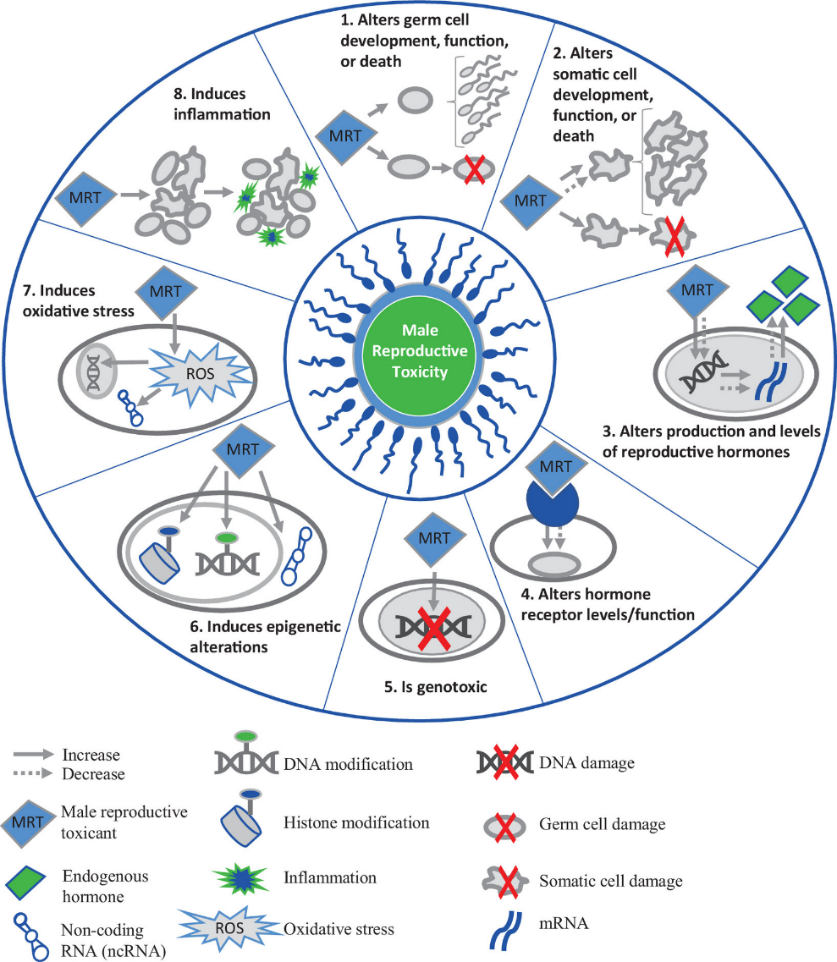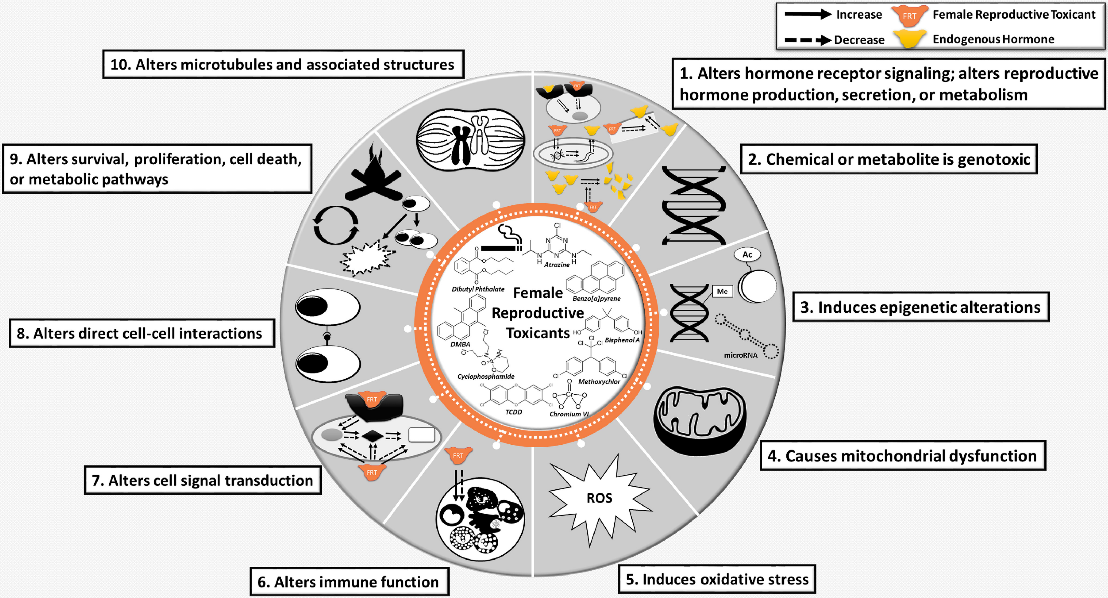Superfund Research Program
Identifying Key Characteristics of Chemicals that Harm Male and Female Reproduction
View Research Brief as PDF(809KB)
Release Date: 09/04/2019
![]() subscribe/listen via iTunes, download(9.2MB), Transcript(88KB)
subscribe/listen via iTunes, download(9.2MB), Transcript(88KB)
Researchers from the University of California, Berkeley (UC Berkeley) Superfund Research Program (SRP) Center developed and applied a “key characteristics” framework to help risk assessors better identify, organize, and summarize the potential reproductive health risks of different chemicals. By understanding specific events that lead to toxicity, they also may be able to systematically predict whether less studied chemicals may be reproductive toxicants and prioritize them for additional study.
Led by UC Berkeley SRP Center Director Martyn Smith, Ph.D., the team built on previous work, which defined key characteristics of chemicals that cause cancer in humans. With the same approach in mind, they convened two separate working groups of international regulatory experts and scientists to identify key characteristics shared by chemicals that are toxic to male and female reproduction.
The working groups reviewed the existing literature and discussed the early changes in cells and organs that may represent key characteristics of reproductive toxicants. These changes occur primarily in the testicles and sperm or in egg cells and ovaries. This can include direct impacts on the ability of reproductive cells to create embryos, as well as longer term impacts on embryo viability and development.
Key Characteristics of Male Reproductive Toxicants

The first working group evaluated a list of chemicals known to target the male reproductive system, including pharmaceuticals, drugs such as opiates or alcohol, and toxicants such as cadmium, polychlorinated biphenyls, and pesticides. From this list, they identified eight shared key characteristics of male reproductive toxicants.
For example, altering the development, function, or death of sperm cells was one key characteristic. Sperm cells are vulnerable to chemical stressors during all developmental stages. The working group pointed to studies linking exposure to benzo[a]pyrene (BaP) or cadmium with increased sperm cell death and reduced sperm motility. They also highlighted toxicants that decreased sperm cell number and altered sperm morphology.
The working group identified alterations in the production of hormones, including gonadotropins, sex steroids, and thyroid hormones, as a key characteristic of male reproductive toxicants. These hormones play important roles in the normal development and function of the male reproductive system. For example, the group noted several studies linking exposure to phthalates, PCBs, BaP, or opiates with reduced androgen production and levels. Similar to other important sex steroids, they explained that androgen deficiencies can result in abnormal reproductive anatomy and infertility.
Key Characteristics of Female Reproductive Toxicants

Another working group evaluated a list of chemicals known to target the female reproductive system, including pharmaceuticals, cigarette smoke, and toxicants such as polycyclic aromatic hydrocarbons (PAHs), bisphenol A, and pesticides. Through systematic evaluation of the literature on the underlying mechanisms, they identified ten key characteristics of female reproductive toxicants.
For example, the group found that toxicants often alter the interactions between cells, particularly during follicle development and the process of fertilization. As evidence, they pointed to studies in which exposure to PAHs interfered with interactions between developing egg cells and important cells in the ovary that provide blood supply and nutrients. Studies also were highlighted showing that BaP exposure early in development reduced the ability of mature eggs to fuse with sperm to create an embryo.
Another key characteristic the experts agreed on was that toxicants alter microtubules, hollow shafts that give structure and shape to a cell, and related structures. They pointed to studies showing that cigarette smoke, diesel exhaust, and BPA exposure can interfere with microtubule functions, leading to chromosomal abnormalities. Additional studies explain how cigarette smoke exposure interferes with other microtubule functions, which can be a factor in infertility and ectopic pregnancy, a condition in which an embryo implants somewhere other than the uterus, such as in the fallopian tubes.
Key Characteristics Inform Health Protective Decisions
According to the working groups, these characteristics help lay the groundwork for understanding how fertility and reproductive health are affected by exposure to harmful chemicals. The authors stress that having one or even several of these characteristics does not conclusively identify a chemical as a male or female reproductive toxicant. Rather, since it would be nearly impossible to test all chemicals in use for their toxic effects, they explain that risk assessors could prioritize those chemicals having one or more key characteristics for additional toxicity testing. The authors also suggest this method may be useful in conjunction with a data science approach to predict toxicity and prioritize chemicals for further study.
The team plans to facilitate additional working groups of experts focused on identifying key characteristics of chemicals that harm the brain and development, as well as chemicals that harm the heart. Ultimately, Smith and colleagues hope to identify key characteristics of harmful chemicals more broadly, regardless of the specific body system that is targeted.
For More Information Contact:
Martyn T Smith
University of California-Berkeley
School of Public Health
Environmental Health Sciences Division
Berkeley, California 94720-7360
Phone: 510-642-8770
Email: martynts@berkeley.edu
To learn more about this research, please refer to the following sources:
- Ahearn A. 2019. Key characteristics: a new approach to identifying potential toxicants, with Martyn Smith. The Researcher's Perspective 2019(1):doi:10.1289/EHP5776
- Arzuaga X, Smith MT, Gibbons CF, Skakkelmek NE, Yost EE, Beverly BE, Hotchkiss AK, Hauser R, Pagani RL, Schrader SM, Zeise L, Prins GS. 2019. Proposed key characteristics of male reproductive toxicants as an approach for organizing and evaluating mechanistic evidence in human health hazard assessments. Environ Health Perspect 127(6):65001. doi:10.1289/ehp5045 PMID:31199676 PMCID:PMC6792367
- Luderer U, Eskenazi B, Hauser R, Korach KS, McHale CM, Moran-Messen FM, Rieswijk L, Solomon G, Udagawa O, Zhang L, Zlatnik M, Zeise L, Smith MT. 2019. Proposed key characteristics of female reproductive toxicants as an approach for organizing and evaluating mechanistic data in hazard assessment. Environ Health Perspect 127:75001. doi:10.1289/ehp4971 PMID:31322437 PMCID:PMC6791466
- Smith MT, Guyton KZ, Gibbons CF, Fritz JM, Portier CJ, Rusyn I, DeMarini DM, Caldwell JC, Kavlock RJ, Lambert PF, Hecht SS, Bucher JR, Stewart BW, Baan R, Cogliano VJ, Straif K. 2016. Key characteristics of carcinogens as a basis for organizing data on mechanisms of carcinogenesis. Environ Health Perspect 124(6):713-721. doi:10.1289/ehp.1509912 PMID:26600562 PMCID:PMC4892922
To receive monthly mailings of the Research Briefs, send your email address to srpinfo@niehs.nih.gov.


